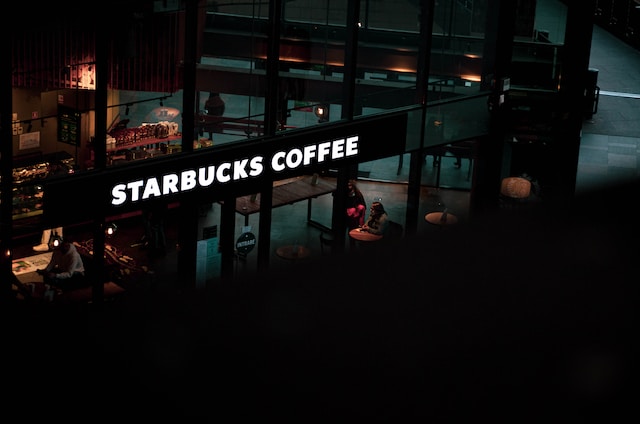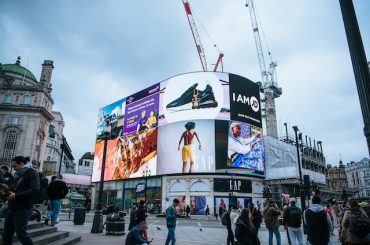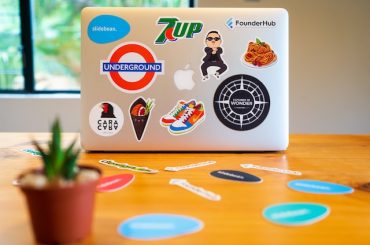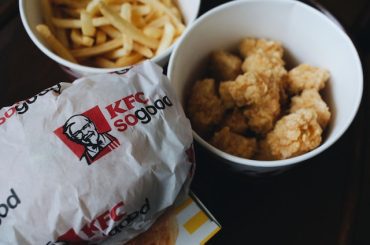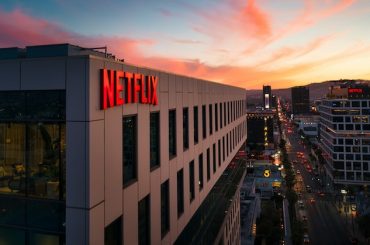Before we dive deep into the Marketing Mix (4Ps), let’s get the business overview of Starbucks. Starbucks Corporation, founded in Seattle, Washington, in 1971, has grown to become the world’s largest coffeehouse chain and one of the most recognizable brands in the specialty coffee industry. Known for its iconic green mermaid logo, Starbucks has expanded its presence globally, with more than 35,700+ stores in over 80 countries as of 2022.
Business Model: Starbucks operates under a retail and franchise model, with most company-operated stores (51%). The company primarily generates revenue by selling premium coffee and other beverages, including espresso-based drinks, teas, and smoothies. Additionally, Starbucks offers a variety of food items such as sandwiches, salads, pastries, and snacks. The company also sells coffee beans, ground coffee, and single-serve products for at-home consumption.
Starbucks strongly focuses on providing a consistent and comfortable in-store experience, emphasizing customer service and an inviting atmosphere. Many stores offer free Wi-Fi and ample seating to encourage customers to spend time in the stores. The company has also developed a successful loyalty program called Starbucks Rewards, which offers exclusive deals and promotions to members.
Diversification and Expansion: Over the years, Starbucks has diversified its product offerings by launching new lines of beverages, such as the Teavana range of teas, and acquiring other companies, including Evolution Fresh (a cold-pressed juice company) and La Boulange (a bakery chain). The company has also entered the ready-to-drink (RTD) market through partnerships with PepsiCo and Anheuser-Busch InBev.
Furthermore, Starbucks has expanded its operations beyond physical stores by introducing various digital initiatives, such as mobile ordering and payment through the Starbucks app. This has enabled the company to reach new customers and streamline the in-store experience.
Sustainability and Corporate Social Responsibility: Starbucks is committed to addressing social and environmental issues, focusing on ethical sourcing, sustainable packaging, and minimizing its carbon footprint. The company has implemented the Coffee and Farmer Equity (C.A.F.E.) Practices that promote fair trade, improved working conditions, and environmentally responsible farming methods.
- Global comparable store sales increased 8%, driven by a 5% increase in average ticket and 3% increase in comparable transactions North America and U.S. comparable store sales increased 9%, driven by a 6% increase in average ticket and 3% increase in comparable transactions
- International comparable store sales increased 5%, driven by a 5% increase in comparable transactions; China comparable store sales increased 2%, driven by a 4% increase in comparable transactions and 2% decline in average ticket
- Consolidated net revenues up 12%, to a record $36.0 billion, or 14%, excluding a 2% unfavorable impact from foreign currency translation
Starbucks business model & supply chain analysis
Here is the Marketing Mix (4Ps) for Starbucks
A marketing mix, also known as the 4Ps of marketing, is framework marketers use to develop and implement effective marketing strategies. The concept helps businesses identify and optimize the key components necessary to promote and sell their products or services. The 4Ps of the marketing mix are Product, Price, Place, and Promotion.
In addition to the traditional 4 Ps, marketers have expanded their strategies by incorporating additional elements (People, Process & Performance) to help them better understand and reach their target audiences. But we will focus on the 4Ps as they still are the foundation of any marketing strategy. In this article, we will understand the marketing mix (4Ps) of Starbucks.
What is a Marketing Mix? What are the 4Ps of Marketing?
Product
- Coffee: Starbucks offers a variety of coffee blends, such as espresso, drip-brewed, and cold brew. They have a range of coffee beverages like lattes, cappuccinos, macchiatos, Americanos, and more. Starbucks also sells coffee beans and ground coffee for customers who prefer brewing their coffee at home.
- Non-coffee beverages: In addition to coffee, Starbucks serves an assortment of non-coffee beverages, including teas, hot chocolate, smoothies, and a selection of cold drinks like iced teas, lemonades, and refreshers.
- Food items: Starbucks offers a range of food items, such as pastries, sandwiches, salads, breakfast items, and snacks, to complement its beverages. The menu varies by location and often includes both sweet and savory options.
- Seasonal and limited-time offerings: Starbucks regularly introduces seasonal beverages and food items, like the famous Pumpkin Spice Latte during the fall or the Peppermint Mocha during the holiday season. These limited-time offerings help create a sense of excitement and novelty among customers.
- Merchandise: Starbucks sells branded merchandise, such as mugs, tumblers, coffee makers, and other accessories, both in-store and online. This allows customers to purchase items that represent their affinity for the brand.
- Loyalty program and mobile app: Starbucks’ loyalty program, Starbucks Rewards, and the Starbucks mobile app are also part of the company’s product offerings. These provide customers with a more personalized and convenient experience, including mobile ordering, payment options, and the ability to earn rewards for their purchases.
Price
- Premium pricing: Starbucks sets its prices higher than many competitors, reflecting the premium quality of its products, ingredients, and overall customer experience. This premium pricing strategy contributes to the brand’s image as a high-quality, sophisticated coffee provider and associated products.
- Value perception: Despite higher prices, Starbucks creates a perception of value by offering exceptional customer service, comfortable and inviting store environments, and a diverse product range. This helps justify the premium pricing and enhances the overall customer experience. Starbucks prices products on value, not cost. Why?
- Customization: Starbucks allows customers to customize their beverages, which enables them to create a personalized experience that caters to their taste preferences. While customization options may affect the product’s final price, it also provides a sense of value to the customers, as they can tailor their drinks to their liking.
- Geographic pricing variations: Starbucks adjusts its pricing based on local market conditions, cost structures, and competition. This means that prices for the same product may differ across different locations, countries, or regions.
- Loyalty program and promotions: Starbucks offers its Starbucks Rewards loyalty program, which provides members exclusive benefits, such as free drinks or food items, birthday rewards, and personalized offers. These incentives help build customer loyalty and enhance the perception of value, even with premium pricing.
- Price tiering: Starbucks has introduced different price tiers for some of its products, providing more affordable options alongside its premium offerings. This strategy allows the company to cater to a broader range of customers and remain competitive in various market segments.t
Place
- Store locations: Starbucks has a vast network of stores across the globe, with thousands of locations in different countries. The company strategically selects locations for its stores, often placing them in high-traffic areas such as city centers, shopping malls, office buildings, and transportation hubs. This approach ensures maximum visibility and accessibility for customers.
- Store layout and design: Starbucks invests in creating a consistent and appealing store design to provide customers with a comfortable and inviting atmosphere. The store layout typically includes ample seating areas, warm lighting, and elements that reflect the brand’s identity. This consistency in design helps establish a recognizable brand experience and ambiance for customers, regardless of the specific location.
- Drive-thru locations: In response to customer demand and changing preferences, Starbucks has introduced drive-thru locations, allowing customers to purchase their favorite beverages and food items without leaving their vehicles. This enhances convenience and caters to customers in a hurry or who prefer not to enter a physical store.
- Licensed stores and partnerships: Starbucks has partnered with other businesses, such as airports, supermarkets, and hotels, to expand its presence and make its products available to a broader customer base. These partnerships often involve licensed stores operated by the partnering business but offer Starbucks products and adhere to the company’s quality standards.
- E-commerce and mobile app: Starbucks also leverages digital channels to enhance customer convenience. The Starbucks mobile app allows customers to place orders ahead of time, pay for their purchases, and access the Starbucks Rewards loyalty program. Additionally, Starbucks sells merchandise, coffee beans, and other products through its online store.
- Wholesale distribution: Starbucks sells its products, such as coffee beans, bottled beverages, and single-serve coffee pods, through various retail channels, including grocery stores and online retailers. This strategy helps the company reach a broader audience and increase brand exposure.
Promotion
- Advertising: Starbucks uses various advertising channels, such as print, digital, social media, and out-of-home advertising, to reach its target audience. The company creates visually appealing and engaging content that showcases its products and highlights the brand’s values and commitment to quality. How does Starbucks’ unique promotion strategy aid in its massive success?
- Social media: Starbucks maintains a strong presence on social media platforms like Facebook, Instagram, Twitter, and Pinterest, sharing updates, promotions, and engaging content with its followers. The company uses social media to interact with customers, showcase new products, and create a community around the brand.
- Public relations: Starbucks leverages public relations to generate positive media coverage and maintain a favorable image in the public’s eye. The company often shares news about its corporate social responsibility initiatives, sustainability efforts, and new product launches to create buzz and reinforce its reputation as an industry leader.
- Seasonal and limited-time promotions: Starbucks introduces limited-time offerings and seasonal products, such as the Pumpkin Spice Latte and holiday-themed drinks, to create excitement and encourage customers to visit stores. These promotions often generate significant attention and help the company capitalize on trends and consumer preferences.
- In-store promotions: Starbucks utilizes in-store promotional materials, such as menu boards, signage, and point-of-sale displays, to inform customers about new products, discounts, and special offers. These promotions help drive sales and create an appealing in-store experience.
- Loyalty program: Starbucks Rewards, the company’s loyalty program, is a promotional tool to incentivize repeat purchases and enhance customer loyalty. Members can earn rewards, such as free drinks or food items, and receive personalized offers and promotions.
- Partnerships and collaborations: Starbucks engages in partnerships and collaborations with other brands, artists, and celebrities to create unique, limited-edition products and co-branded experiences. These collaborations generate buzz, attract new customers, and strengthen the brand’s image.

